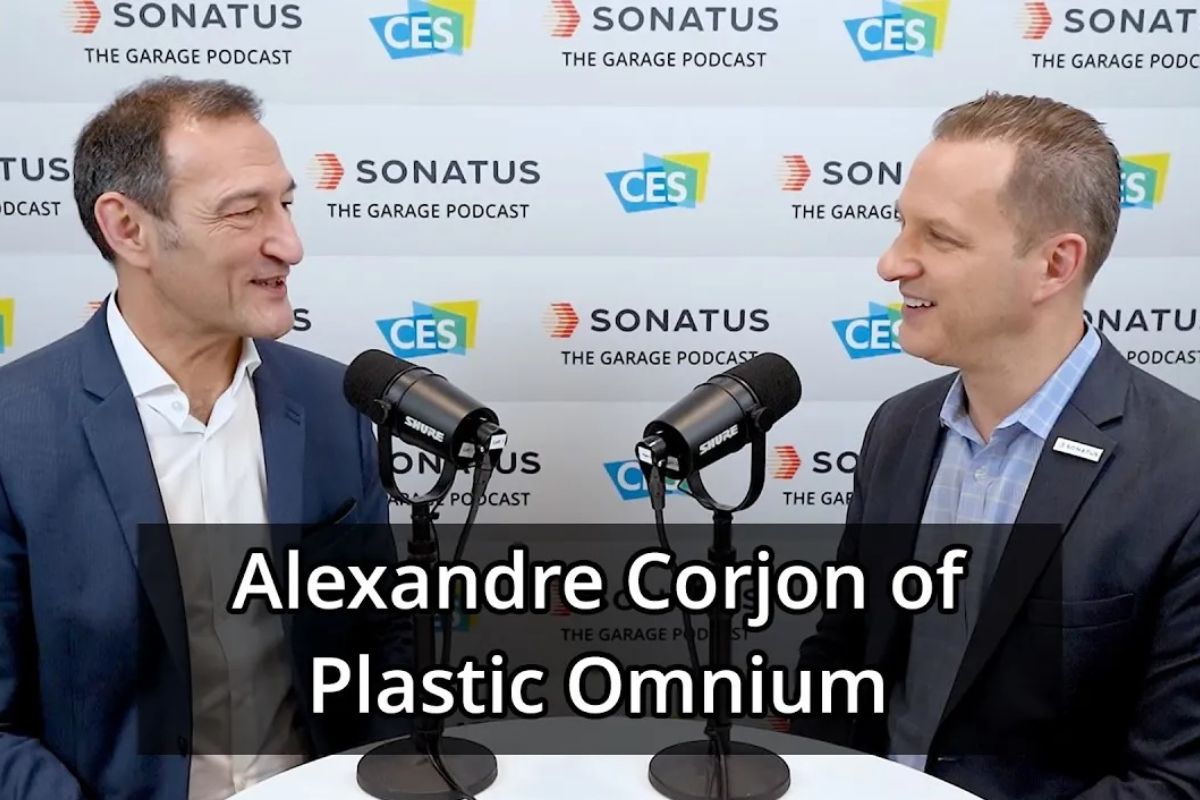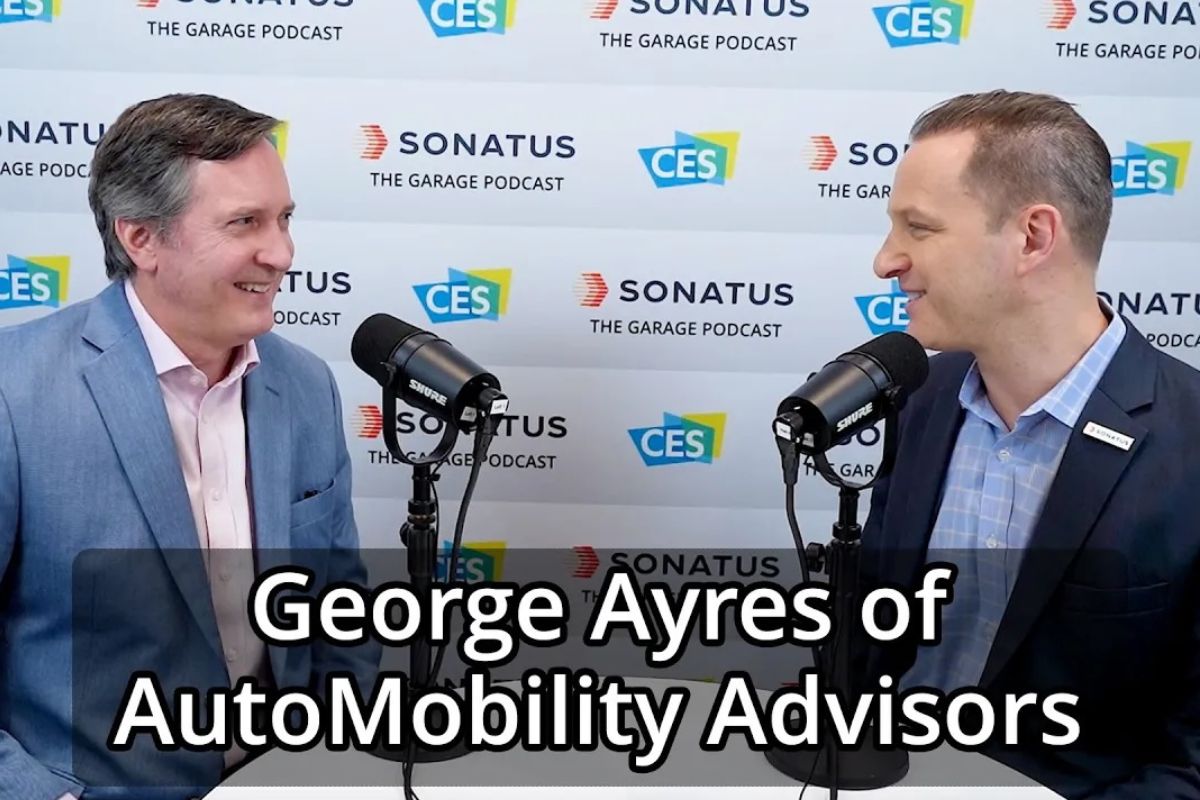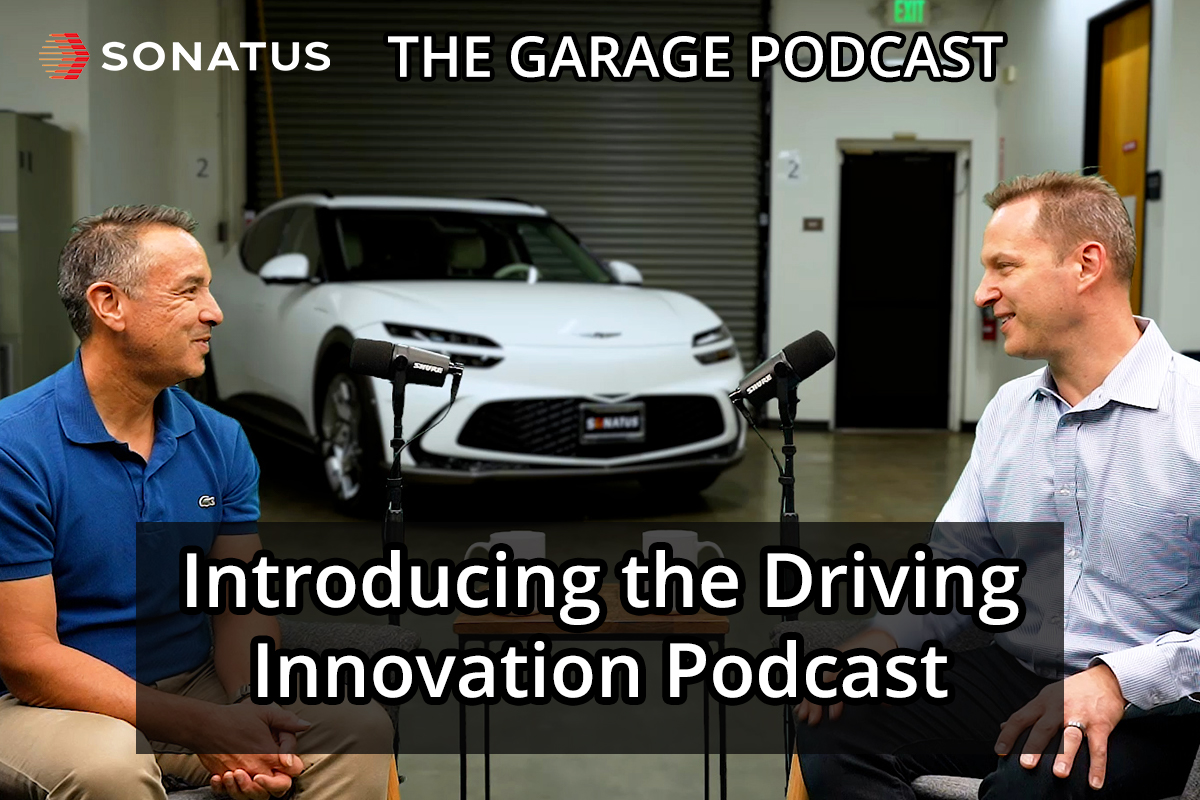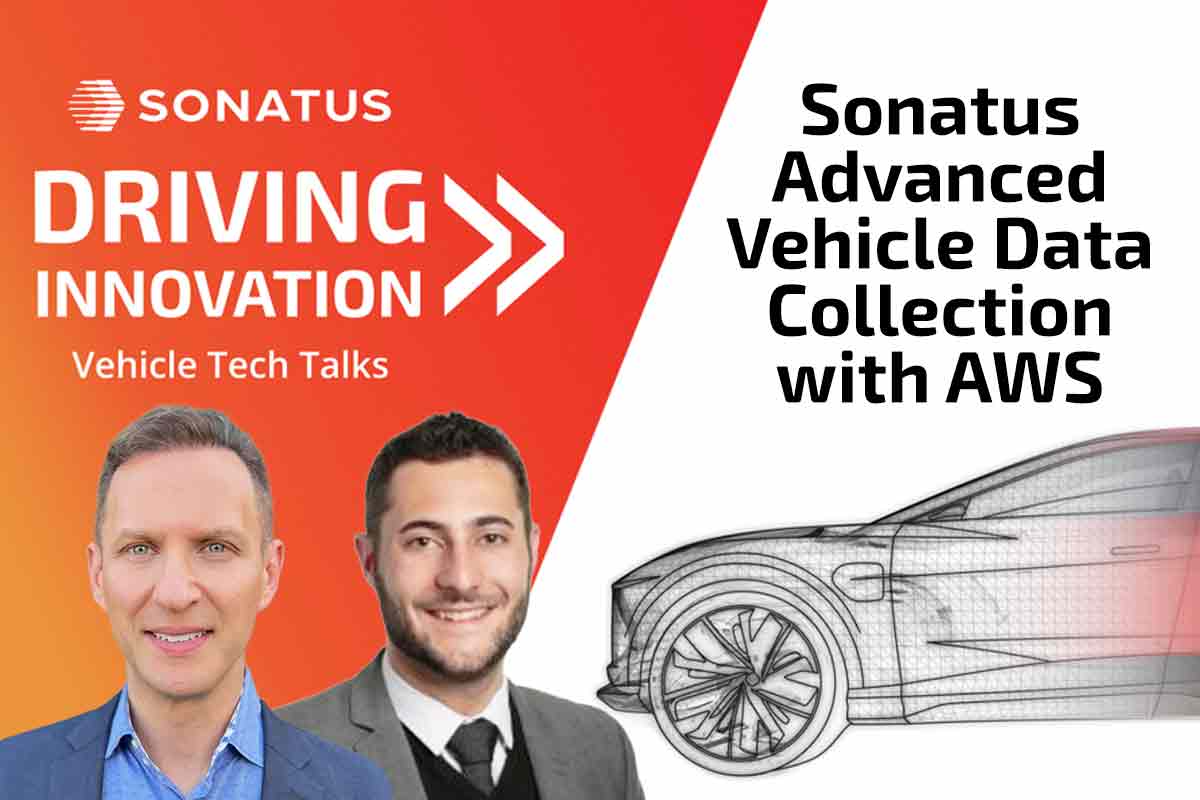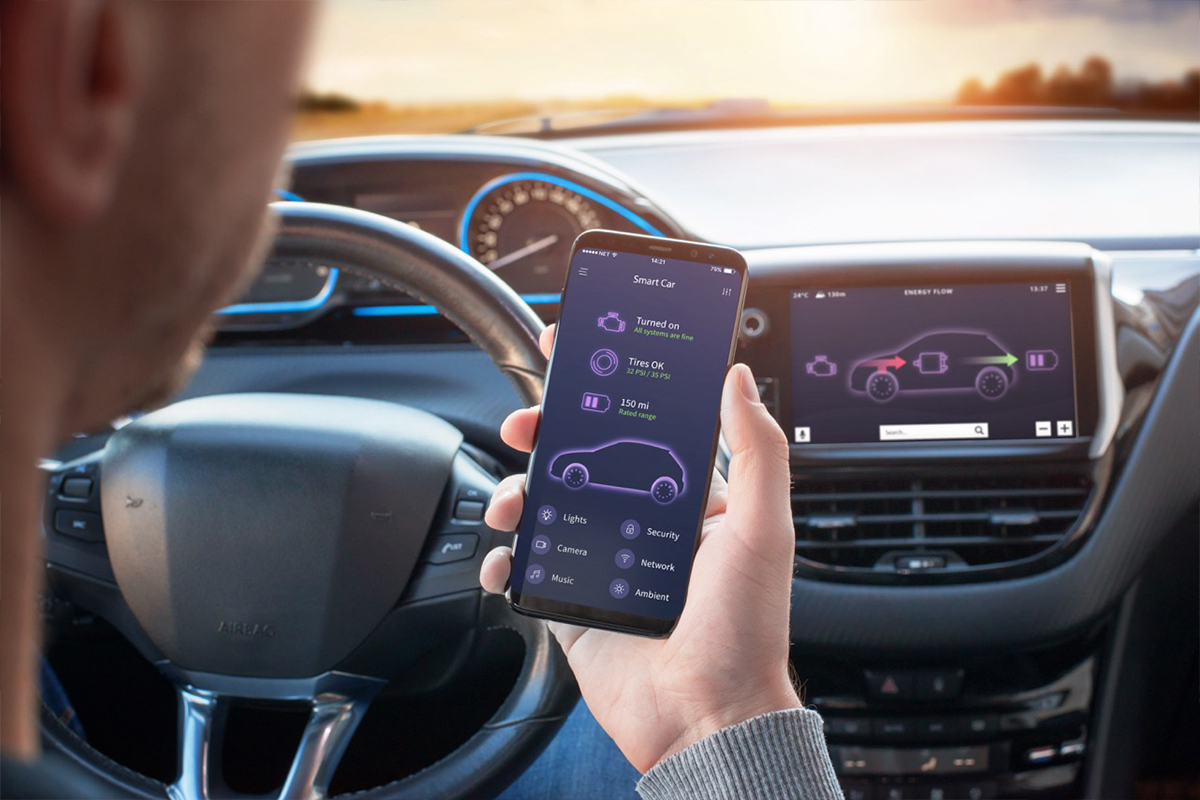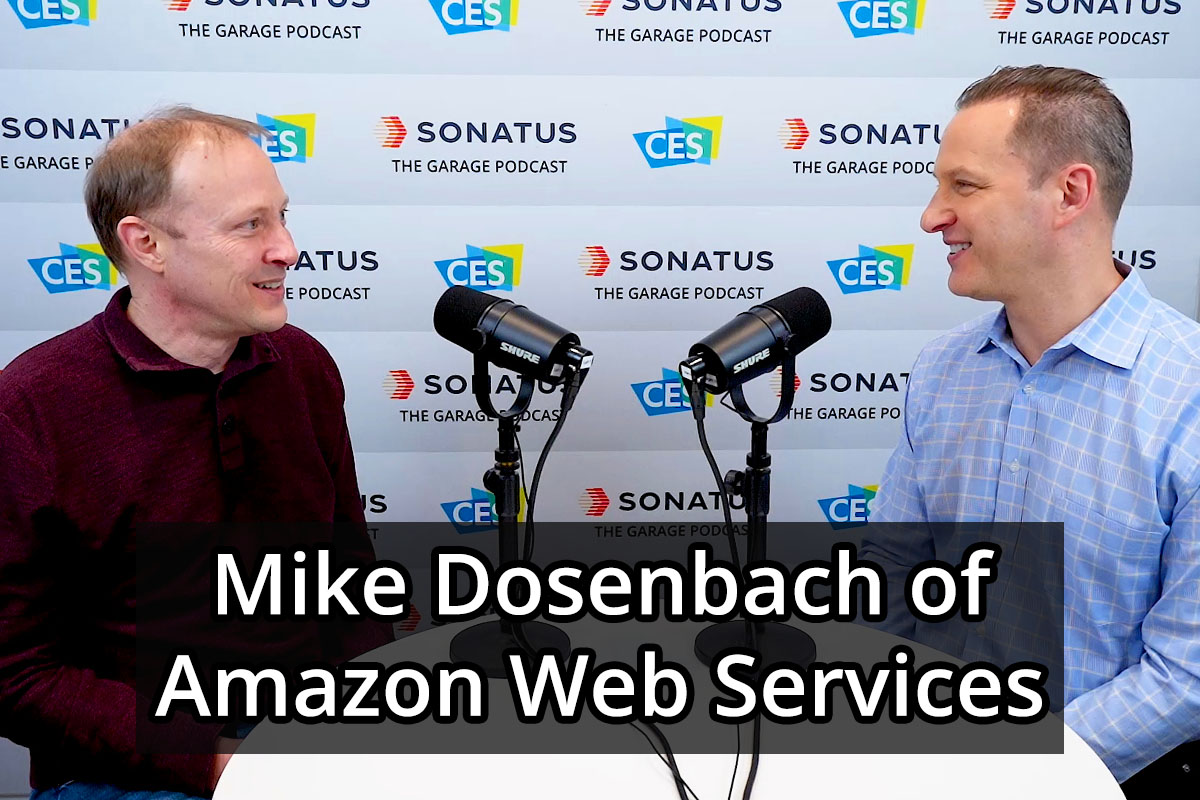Overview
Live from CES 2024. Welcome to The Garage with AWS. Let’s go!
Welcome to The Garage. This is another of our live episodes recorded at the Consumer Electronics Show 2024 in Las Vegas. We’re so pleased today to welcome our good friend from AWS Mike Dosenbach. Mike, welcome to The Garage.
Thank you for having me.
Meet Mike Dosenbach
Mike, tell us a little bit about yourself and what do you do for AWS?
Yeah, so I’ve spent my career in software development. I went, worked on a bunch of different things, but about seven years ago I joined an OEM and I was running a software development office for them. Spent about five years there and I’ve done a lot of startups, I’ve done a lot of- I’ve worked at Amazon previous to going to this OEM.
And once I joined that, my father finally thought I was doing something worthwhile because now I am the fourth generation in the automotive industry.
It’s funny how parents have an interesting view. My parents couldn’t tell you what I do to save their life.
Yeah, I think that’s what he liked, is that this time he finally could.
He finally understood. And I always like to ask my guest to tell us some fun fact about you. Something maybe people don’t know about you.
Sure. So there’s really nothing that very few people know about me. I’m very open. But one of the things that I like to do outside of work is play hockey. I play goalie.
And you have all your teeth though.
Yeah, well, that’s because I’m a goalie. Yeah, we wear big helmets.
But two of my kids followed into that path, and now they are both the goalies for hockey. And in fact, my daughter is in a boarding school in Boston just so she can get better training.
Yeah, that’s great. Well, I always like to come back with an interesting fact about myself. Every time I have to do a different one.
I would say a fun fact is my daughter actually loves to ice skate. So she’s more figure skating, although there’s all these girls that do hockey, too. It’s great.
Yeah.
But she’s into figure skating and actually loves it a lot. It’s her new- It’s kind of her sport. Yeah, Very good.
Very good.
Developing solutions together with customers
So let’s dig into this and let’s talk about software-defined vehicles. And really, vehicle software is kind of the general focus of The Garage. So tell me about what you’re focusing on. What are some key trends you see in the industry right now? So one of the big things that I’m seeing over the last five years or so is that the OEMs are starting to work more in partnership with the tech companies. Allowing us to work together rather than the tech companies being treated as suppliers or even competitors. At AWS, you know, the way that we work is we start with the customer and we work backward from there. And so the way that we work is really modeled well for this partnership side of things. The department that I’m in, AWS Industry Products, that’s exactly what we do. So we build general-purpose, generally available, services for specific industries. I’m in the Auto Department there, right?
Right.
And so what we do is we go and we partner with automotive companies and jointly build something. We build a product that AWS will then bring to the market for all customers. And then our customer, our partner, will build the parts that they’re really good at, and add to it. And so overall they’ll have a great end-to-end solution that works perfectly together because we built it together.
That’s great.
Right? And so we’re finding a lot of traction in this business model. And it just shows that, you know, both sides, the tech and the OEM, we’re coming together to really help customers.
That’s great. You know, I’ve been working with Amazon for years, and last year, in season one of The Garage, we had Stefano Marzani, a fantastic leader, on the show and actually we’re pleased that earlier this week Sonatus and Stefano both won MotorTrend Software-Defined Vehicle Innovator Awards, so we’re pleased.
Congratulations.
We’re extra happy to win, for our company to win, the same day that he won.
Right.
You know, that’s fantastic. And I also understand this customer-facing model is really true. I mean, you really have a customer-first approach. Actually at Sonatus we feel a very similar idea. I’m not comparing ourselves to you, but in the sense of being customer-first. We really are trying to- we’re not trying to replace customers. We’re not trying to replace the design teams and customers. We’re trying to elevate them. I think in the same way that you’re providing some standard products that they can build on, but then add their differentiation. It’s very much the same approach at Sonatus is using. That were providing some infrastructure that then they can add their differentiation and it seems to be getting good reception.
Yeah, I agree.
Virtualization of ECU’s in the cloud
So what are some of the most important evolutions you see in the automotive industry that you’re working on?
So I mean, there’s a bunch of them, but three of them I think I’d like to talk about real quick if we could. First is virtualization of ECUs. So at my time at the OEM, we had ECUs that were prototypes, that were the operating system, things like that. The low-level software was put on them, shipped to us from overseas.
Right.
We would run it in our lab and put our software on top of that. Right. And that worked okay, except it doesn’t scale, right? It doesn’t scale it. All of these prototypes, this hardware is very expensive. It’s fragile because it is a prototype. If it got bricked for some reason, we had to send it back overseas and wait for a replacement. And so it slowed down our development process quite a bit.
It’s hard to test interoperability that way too.
I completely agree. Yeah, absolutely. You can’t have that networked set of ECUs because each one of them may not be critical to what I’m doing on a day-to-day basis. But then you don’t find a lot of the bugs until the integration which comes in unfortunately much later in that model.
Right.
So what I’ve seen a lot of just recently over the last couple of years is that virtualization of ECUs.
Okay.
So taking that software package and putting it into the cloud, running it on compatible hardware as close to the exact hardware as you can get. Right.
And you know, things like ARM chips makes this a lot easier.
Right, AWS Graviton has really unlocked the power of this.
Yeah, well, you know, for us that is the game changer is Graviton. And so we have already taken QNX and we have AMIs that run QNX in the cloud and you can scale up a thousand different instances if you want to.
And you just get a prompt and it’s just as if you had real hardware.
Yeah exactly. And so, you know it’s not going to catch everything.
Sure.
There’s, you know, thermal bugs that happen in the real world and you know, a bunch of stuff that only happens in the real world.
But you know, the perfect is the enemy of the good here. And I think if you can really take that kind of scalability because you can get — while certain physical things, you can’t get — there are other things that you couldn’t get the other way. Exactly. Where you can get network effects, you can get contention, you can get starvation, those kind of things that are really…And you can in fact, you can even stress those areas and say, let’s actually cause contention, that actually might be hard to cause in a real car just to see how close to the edge we are.
Yeah, I completely agree. And it saves a lot of manpower. And you have these people who in the old world, their job is to drive around a car for thousands of kilometers or miles or whatever. And they just spent hours and hours of of time just driving and testing. You can get 90% of that value virtualizing it, and then have these experts working on the hard problems.
Right. That’s fantastic. And it’s so important. We see that as an important trend. It’s something we do a limited amount of that today. And we’re looking to continue to expand that. Some of the testing we used to do with physical hardware infrastructure, you have, you know, power cycling, you can sort of remotely power cycle the thing. Now we do in the cloud. A lot of our development has happened first and foremost in AWS and we’re able to prototype in that way much more scalable, much more cost-effective.
Yeah, exactly. And then, you know, just here at the show, we announced a partnership that we have with Stellantis where we helped them set this stuff up and the results are showing a 100-fold increase in development time. Or a decrease in development time.
So a sort of shift-left- the shift-left idea that the other people have talked about.
Yeah, that’s exactly right.
Virtualizing where software runs
Yeah, that’s really important. So that’s the first trend. What’s the second trend you think is critical right now?
It’s somewhat related in that the virtualization of the software ecosystem within the vehicle. So adding abstraction layers within your ECUs. And as you’re getting more and more functionality and fewer number of ECUs, this becomes more of a viable way forward. So we have these abstraction layers and you can write software once and run it on any number of your vehicles.
Right.
Right? And OTA is not new, but this makes it easier. You don’t have to have, you know, 150 different versions of a package that allows you to deliver, you know, to deliver to your different makes, models, model years, etc. within your fleet. And this also, these abstraction layers, can add a lot of value as well. And one of the products that we’re working on with a partner, it’s it allows you to run machine-learning models and complex algorithms on the edge, in the vehicle. And so this goes to kind of my next point, but it allows you to process things and get inferences within the vehicle to both control the amount, or control the functionality in the vehicle based off of customer behavior or something else, and also decrease the amount that you have to send out to process.
Right. So we talked earlier about consolidation. We see consolidation as a very important trend. And it’s kind of, for me, I think it’s a kind of a cousin to this because as you’re abstracting things away and as you’re virtualizing workloads, you might have had two different ECUs, two different literally black boxes before that now become shared software virtualized side by side that don’t know they’re there not unlike how things are in your cloud side by side that don’t know they’re there.
Yes.
But it helps you save costs, save vehicle weight. There’s a big focus in the industry in saving vehicle weight and consolidation is a part of that. But if we don’t do it in a smart way, then it’s not effective. Yeah.
And I think another thing that it allows is kind of an idea that I’ve had for a while but just hasn’t really been able to — the technology isn’t there to make it happen yet — is really virtualizing where your software is running. Depending on real-world situations and what’s happening in the vehicle and how much connectivity you have, the vehicle can decide where to run workloads, whether it’s on the car, at the 5G edge or in the cloud.
Right.
So if you have that abstraction layer, then you can just decide at that time where it’s going to run.
Right. You know, I was at Arm for a long time, and at Arm we helped to create the SOAFEE initiative. I was proud to be one of the people on the team who helped create that. And that was one of the ideas and Amazon was an early partner in that initiative helping to allow workload portability service-oriented architecture that allows you- And it might be in a high connectivity environment. You’ve got incredible wireless connection, maybe you send things to the cloud more aggressively, maybe you’re in a low connectivity environment, you have to do things more locally or somewhere in between. I think that’s a general trend that’s growing more and more in the industry and AWS is at the forefront of that, I think.
Hope to be.
Joint demonstration between Sonatus and AWS
Great. And then I think while you were talking about that artificial intelligence, you alluded to that as well. AI is growing in importance. We’re showing a demonstration here at the show, which we’re really pleased to have developed, where we’re leveraging our Sonatus collector product together, fine-grained data in a vehicle, for example, in a scenario, you can imagine where there’s an ADAS problem and you want to diagnose it quickly.
Right.
But- And that’s great. And we’re really proud of that solution. And it’s very unique. But you also need additional information. And so we’re working with AWS to, what we call enrich that data, to add other information like manufacturing data, like A/B testing of ADAS models or, and recognition in the cloud. So we can very quickly tailor the data that the ADAS engineer needs to fix a problem.
Right.
And more and more you’re also seeing machine-learning being integral to that. So adaptively figuring what data to collect and adaptively seeing patterns that maybe humans wouldn’t see, but AI is like, “Well it’s obvious. It’s right there.”
Right, Exactly. And even, you know, rule-based models are great and they work for most things, but ML/AI gives you that additional insight into what’s happening and will catch patterns that you haven’t even thought of yourself yet.
Right.
Right? And yeah, no, I love the collector product that you have put together. I’m really proud that my team has been able to work with you on small parts of that.
It’s been a fantastic collaboration.
The response to it has been fantastic. Everyone really sees the value of it and the fact that this partnership is great. And it really unlocks the whole ecosystem because you have so many rich partners of all different types, manufacturing partners, you know, OEMs, tire companies, Tier 1s and everything. And bringing all that data together in the cloud is really powerful. I like to say one plus one equals three, and maybe it’s one plus one equals 17 when we’re all done because this is really great.
Yeah, last year when I was here and looking around at the booths, I saw a lot of that type of thing. But it was still pretty primitive. And walking around this time everything is much slicker. It’s more consumer-focused. It made a huge leap in this past year.
The importance of different kinds of data
Great, great. And what was the third technical area you mentioned?
It’s really about the data. We’ve already started talking about that and it’s how the auto industry is gathering the information and in reality not gathering as much information.
Right.
And how they use it. And, you know, you talked about bringing in datasets from multiple different places within your organization or external. Bringing that all together and being able to use machine learning in order to get those insights so that you can not only help your customer in real-time, but you can make better decisions about the next thing that you’re going to build or how you’re going to modify the things that you already have in order to better serve the customers needs.
Right.
Data is so powerful. I wrote a blog recently like — The kind of slightly cheeky title was “Data isn’t the new oil, data is a new everything.” That was the title of my blog. But I actually really believe that because the companies that are at the forefront are taking insights in much richer ways.
Yeah.
Historically you would have had – and we had product managers that told this story a couple of times – we have the product managers that tell us when the car ships, it’s like a black box. They have no idea how people are using their car, right? How can we empower every different part of the OEM ecosystem, whether that’s a product planner, whether it’s a diagnostics engineer, or whether it’s a dealer who wants to proactively engage with the customer for, frankly, for them for revenue, but also for the customer and for maintenance and so on. How do we enable each of them with different data? Because different data for each. And historically it would have been, well I collect the same 170 signals every 30 seconds and that’s that. But actually that doesn’t address every one of these deep or different problems.
Yes, I completely agree. And it’s we need to get to the place where it’s not just the high-end vehicles that are doing the right things right. And one way to do that is reduce the cost of connectivity. So making decisions in the vehicle and the data that’s actually going to be important. Right. And just get that off the vehicle. Then you can use that. Changing it in real-time, Right? You can change what you’re experimenting with. And be able to, again, like earlier with the virtualization of the software, you can add a lot of value to the cars that are already on the road for the owners of those. Right? The value of the vehicle doesn’t stop increasing once it drives off the lot.
That’s right. That’s right. Yeah, we spoke about that at AutoTech this past year, or this past June saying, you know, the old way of thinking was that the car’s the best it will ever be when you sell it.
Yes.
And the new way of thinking is it’s the worst it will ever be when you sell it, because it just keeps getting better. That story has been told but I really resonate with that. And I think that kind of mindset, I think, is the way we need to think about SDVs in a different way.
Yeah.
SDV is not just OTA
But you talked about putting intelligence in the car because I think everyone thinks, oh it’s just OTA.
Right.
I’ll just do an OTA and that gets better.
Well, yeah, okay. We use an OTA, and just this last week we launched a, we think is a world-leading, OTA solution for vehicles. So OTA absolutely has its place, but it’s only part of the story.
Right.
You also need to have smarts inside the vehicle. And you talked about — my words, not yours — there is a selective filtering of what to capture and what to upload to the cloud. Today we have a solution that allows us to cache data locally, actually to share storage for, you know, economies of scale in a vehicle.
Right.
But another thing that lets you do is it lets you store the data locally and you can dynamically decide, do I stream it up to the cloud instantly if it’s urgent?
Yes.
Or do I cache it here locally, upload it on Wi-Fi or perhaps somewhere in the middle where I maybe, analytically I am saying, “Ah, I’m seeing a pattern. Let me begin to send some additional data up.” I think that was your point.
Yeah, that builds on my point. Yes, absolutely. It’s amazing that when you put that intelligence into the vehicle, how much customer friction that you’ll remove because you know they don’t have to…it’s the predictive maintenance side of things. Whereas if the vehicle knows when it’s starting to break down, you can catch the problem before the driver…
Much less expensive to proactively fix it than later.
Yeah, exactly.
The explosion of generative AI
So comparing last year to this year, one of the things that is unmistakably different is the explosion of generative AI.
Agreed.
And you’re seeing it in so many different applications. What’s your take on it, seeing it across the show today?
Yeah, well, it’s…for a new technology and for one that is probably still immature and has a lot more power to be, you know, to add as we refine it, it has been amazing. I mean, some of the features that we’ve seen here walking around are powered by GenAI and have gone from idea to production in six months because of that.
The pace is unbelievable to see. And as you say, it’s early in the sense that it’s evolving so fast, and imagine where it’ll be in two years.
Right. I mean, even in the last two months there’s been so many changes.
Right. So I think that’s something where we’re only really scratching the surface. We’re seeing some examples of how different OEMs are beginning to use that. But it’s still in the early days. I think it’s going to only continue to grow, and something we’re watching. For us, machine-learning and artificial intelligence is critical to what we’re doing. We’re deploying machine-learning across every one of our products in the years ahead. Sometimes it’s there already and we’re looking to expand it, but I think it’s going to be an exciting time ahead.
Agreed. And it also shows another way that the auto industry is changing. You know, 20 years ago, new technology, they wanted to keep it as far away from the car until it was really proven out. But now that they’re willing to take non safety-related chances on new technology. You see the OEM starting to really embrace this quickly.
Yeah, I mean, look human, you know, humans aren’t designed to have a touch keyboard interface on the screen.
Of course
And we were talking yesterday with Roger Lanctot and he was saying that, you know, the way people interact with cars now, you don’t- they don’t have to learn a vocabulary. They just talk naturally. And I think that’s the trend that’s going to continue as you get more and more natural for how we interact with cars and other devices.
I agree.
Conclusion
Amazon is just doing — AWS — is doing such an amazing focus on automotive.
Thank you.
The booth just down there – it’s just literally 50 feet that way — there’s so much incredible automotive technology in there. It’s always great to work with you. And we were kind of happy and it was a little bit of luck and a little bit of happenstance that we are so close to you physically. But we’ve had guests coming back and forth between our booths all day and it’s been really great to see so many of your folks joining in and sharing presentations. I’m so glad to have you on the show.
Thank you very much.
Thank you for visiting. And let’s stay in touch. We’ll talk to you soon.
Of course.
Absolutely.
If you like what you’re seeing, please like and subscribe to this episode and you’ll see more episodes live from the Consumer Electronics Show 2024 and many more episodes to come in season two of The Garage from our studio as well.
Thank you for watching and we look forward to seeing you again soon.
